BestReviews is reader-supported and may earn an affiliate commission. Details
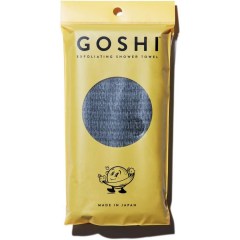
This soft, rip-resistant hand towel is perfect for a good scrub.
This soft, rip-resistant hand towel is perfect for a good scrub.
It’s softer than most exfoliating towels without losing the edge it needs to help remove dead skin and fight breakouts. It’s made of 2 threads woven together to accomplish that. It’s made in Japan.
A few people had allergic reactions to the material. Test it on a small patch of skin before full use.
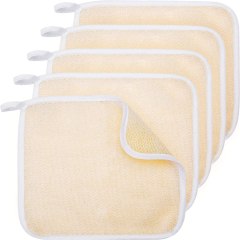
Exfoliating washcloth for both face and body.
Exfoliating washcloth for both face and body.
Stimulates circulation. Nonporous so it dries quickly and does not stain easily. Has a loop to hang for drying. Leaves skin clean and gently exfoliated. Washing machine safe. Foams up nicely. Not scratchy. A cross between a loofah and a washcloth.
May not be good for sensitive skin.
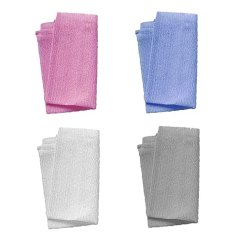
Exfoliating washcloths in assorted colors.
Exfoliating washcloths in assorted colors.
Helps remove dead skin and promotes blood circulation. Leaves skin soft and healthy. Awesome skin buffer. Works for facials, and back and shoulder exfoliation. Lathers well. Larger size that can be cut for use on small areas. Dries well.
May be too rough for some skin types.
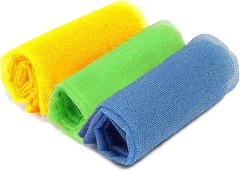
Multicolored nylon exfoliating washcloths.
Multicolored nylon exfoliating washcloths.
Provides great scrubbing action for adequate exfoliation. Long and stretchy enough to scrub your back and other hard-to-reach areas. Easy to clean and dry. Machine wash, but hang dry. Leaves skin feeling soft and clean.
Starts out a bit coarse and gets softer after long-time use.
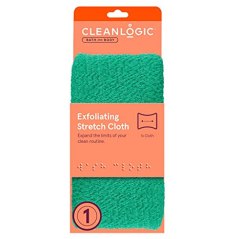
Extra-stretch exfoliating washcloth.
Extra-stretch exfoliating washcloth.
Makes your body feel thoroughly clean and supple. Exfoliates without being too rough. Removes dry skin patches. Stretchy for hard-to-reach places. Optimal for those with limited mobility. Excellent replacement for sugar or salt scrubs.
Does not indicate what color will be shipped.

We recommend these products based on an intensive research process that's designed to cut through the noise and find the top products in this space. Guided by experts, we spend hours looking into the factors that matter, to bring you these selections.

Do you want healthy, radiant skin? It begins with an essential early step in your skincare routine: buffing your body with an exfoliating washcloth.
Exfoliating washcloths are lightly abrasive towels designed to slough away dead skin. Using a gentle circular motion, you can minimize rough and bumpy patches, particularly around the elbows, heels, and upper arms, with an exfoliating washcloth.
One of the most appealing attributes of exfoliating washcloths is that they provide a natural, non-chemical solution for smoothing rough skin. To keep irritation and sensitivities at bay, some exfoliating washcloths are even made from hypoallergenic or plant-derived materials.

Exfoliation can revitalize your appearance by helping your skin look smoother and younger. However, that is not the only reason to exfoliate.
Combat ingrown hairs: If you struggle with ingrown hairs, an exfoliating washcloth can help keep them at bay. Regularly using one before or between shaves teases out ingrown hairs, which in turn can be removed during your next shaving session.
Get an even tan: It’s often recommended to exfoliate prior to using tanning products or getting a spray tan. An exfoliating washcloth makes it easy to smooth bumpy patches, and the smoother your skin, the better and more even your tan application will be.
Unclog pores: Some people with moderate body acne may benefit from regularly using an exfoliating washcloth. Exfoliation removes build-up and dead skin, both of which are notorious for clogging pores and triggering breakouts.
Enhance your moisturizer: Even people with dry skin can use exfoliating washcloths. Gentle exfoliation buffs away dead skin, making it much easier for moisturizing lotions and creams to absorb.
To use an exfoliating washcloth, begin by immersing yourself and the cloth in water. Once the washcloth is saturated, add body wash or soap to create a lather.
Gently buff your body from the neck down, concentrating on rough and patchy areas. Do not scrub harshly, as this will undoubtedly irritate your skin. When you’re done, rinse your body and the cloth thoroughly.
When you leave the bathtub or shower, wring the exfoliating washcloth to remove any remaining water. Allow it to air dry to prevent mold or mildew buildup.
While many people benefit from using an exfoliating washcloth as part of their skincare or shower routine, some people should avoid using them.
Individuals with major skin conditions such as severe acne, eczema, or extreme sensitivity should steer clear of exfoliating washcloths. It’s not recommended to allow children to use them, either, especially since they may use them incorrectly and hurt themselves.

Exfoliating washcloths fall into two size categories: small and large. While both serve the same purpose, one may be more convenient to use than the other.
Small: Small exfoliating washcloths are ideal for those who prefer concentrated buffing, namely around rough or patchy areas like the joints. These cloths are much easier to pack for travel and consume far less space in general. Unfortunately, small exfoliating washcloths can be challenging for people with mobility issues to use.
Large: Large exfoliating washcloths are preferred for quick total-body buffing. Since they’re often long enough to hold with both hands, they make it easy to clean hard-to-reach areas like the back and lower body. One of their pitfalls, however, is that they take up considerable room when they’re hung to dry, not to mention they’re more prone to fraying.
Popular materials for exfoliating washcloths include bamboo, nylon, and mesh. These materials are knitted in such a way that the texture is somewhat coarse. The weave of exfoliating washcloths is fairly loose to allow water and soap to permeate them.
Most exfoliating washcloths have reinforced edges to minimize fraying. However, after a few months of use, it’s common for fraying to occur, even in well-made cloths. For this reason, it’s recommended that you replace your exfoliating washcloth every few months.
Exfoliating washcloths are available in more than one roughness. Unfortunately, very few manufacturers distinguish them. The only exception here is exfoliating washcloths made for sensitive skin, in which case the texture is slightly softer and less abrasive.
If you’re unsure which roughness you need in an exfoliating washcloth, it’s a good idea to buy several to compare. While a softer cloth may feel great, it may not provide deep exfoliation. An abrasive cloth may do the job, but it may be too rough to use more than once or twice a week.
There are a few unique varieties of exfoliating washcloths available.
While exfoliating washcloths can be used on the neck, it’s recommended to exfoliate the décolleté area with a gentler exfoliating product.
Entry-level exfoliating washcloths cost between $4 and $7. For this price, you might get a single cloth or a two-pack in a small or large size. Quality is decent in this bracket, though longevity may be lacking.
For $8 to $12, you’ll find quite a few well-made exfoliating washcloths. The edges of these cloths are reinforced and unlikely to fray. While there are a few single exfoliating washcloths in this price range, there are many multipacks as well.
Premium exfoliating washcloths are priced at $12 and more. These mostly include multipacks as well as unique washcloths with special attributes, such as charcoal infusion.


A. No. Exfoliating washcloths for the body are intended for body use only because they’re far too abrasive for delicate facial skin. There are a few facial exfoliating washcloths on the market, but they’re hit-or-miss with consumers, as many prefer other types of exfoliating products for the face, like facial scrubs and exfoliating masks.
A. While there’s no hard rule on this, it’s not recommended to double-up on exfoliating products. The combined harshness of the exfoliating washcloth and an exfoliating body wash could result in irritated skin. Using both may dry out the skin as well, causing even more patchy roughness.
A. They’re actually quite different from one another, so it’s hard to say. Exfoliating washcloths are used for wet exfoliating, whereas loofahs and body brushes are typically used for dry exfoliation, also called dry brushing. More than anything, it’s recommended that you choose a method of exfoliating that works for you, which could be one or all of these.
Get emails you’ll love.
Learn about the products you’re wondering if you should buy and get advice on using your latest purchases.
